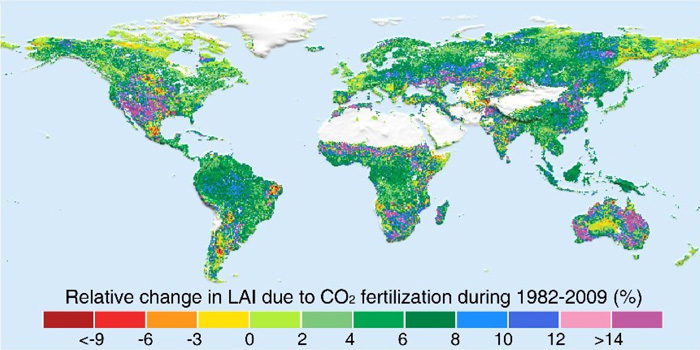| Tweet | Follow @co2science |
Paper Reviewed
Zhu, Z., Piao, S., Myneni, R.B., Huang, M., Zeng, Z., Canadell, J.G., Ciais, P., Sitch, S., Friedlingstein, P., Arneth, A., Cao, C., Cheng, L., Kato, E., Koven, C., Li, Y., Lian, X., Liu, Y., Liu, R., Mao, J., Pan, Y., Peng, S., Penuelas, J., Poulter, B., Pugh, T.A.M., Stocker, B.D., Viovy, N., Wang, X., Wang, Y., Xiao, Z., Yang, H., Zaehle, S. and Zeng, N. 2016. Greening of the Earth and its drivers. Nature Climate Change DOI: 10.1038/NCLIMATE3004.
Among the many climate-alarmist fears of CO2-induced global warming is the concern that the productivity of the biosphere will decline if global temperatures rise to the extent predicted by computer models. Yet, for many alarmists, the future is the present. Since 1980, for example, the Earth has weathered three of the warmest decades in the instrumental temperature record, a handful of intense and persistent El Niño events, large-scale deforestation, "unprecedented" forest fires, and the eruption of several volcanoes. Concurrently, the air's CO2 content increased by 16%, while human population grew by 55%. So just how bad is the biosphere suffering in response to these much-feared events? Or, is it even suffering at all? A new paper by Zhu et al. (2016) provides valuable insight into this important topic.
Noting that global environment change is rapidly altering the dynamics of terrestrial vegetation, Zhu et al. set about to discover just how significant this phenomenon is, as well as what has primarily been responsible for it. This they did using three long-term satellite-derived leaf area index (LAI) records, together with the output of ten global ecosystem models, which they employed to study four key drivers of LAI trends (atmospheric CO2 enrichment, nitrogen deposition, climate change and land cover change) over the period 1982-2009. And what did this effort reveal?
The 32 researchers -- representing 9 different countries (Australia, China, France, Germany, Japan, Spain, Switzerland, the United States and the United Kingdom) -- report finding "a persistent and widespread increase of growing season integrated LAI (greening) over 25% to 50% of the global vegetated area, whereas less than 4% of the globe shows decreasing LAI (browning)." And equally importantly, they report that "factorial simulations with multiple global ecosystem models suggest that CO2 fertilization effects explain 70% of the observed greening trend, followed by nitrogen deposition (9%), climate change (8%) and land cover change (4%)."
Could one hope for anything more promising than this? Quite the opposite of what the world's climate alarmists contend should be happening to Earth's vegetation, rising atmospheric CO2 enrichment is proving to be a tremendous biospheric benefit, overpowering the many real and negative influences that society and nature have inflicted upon it over the past three decades, as shown in the figure below.

Figure 1. Spatial pattern of relative change of LAI due to CO2 fertilization during 1982 to 2009. The relative change of LAI in each pixel is derived from the ratio of the increment of LAI driven by elevated atmospheric CO2 to the 28-year average value of LAI simulated by model ensemble mean under scenario S1. Source: Figure S12, supplementary information from Zhu et al. (2016)




